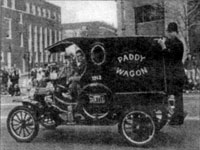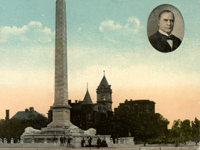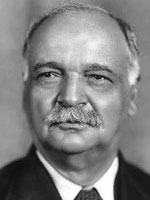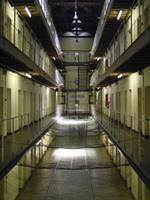The Adorable Origins of Yellow Journalism
Rachel Quimby looks at the pop culture icon the Yellow Kid and the connection of this figure with yellow journalism.
Rachel Quimby looks at the pop culture icon the Yellow Kid and the connection of this figure with yellow journalism.

This collection of essays, documents, and bibliographies addresses Atlantic slavery, resistance, and abolition. Source Documents includes about 200 speeches, letters, cartoons, graphics, and articles (visitors may browse by author, date, subject, or document type—no searching), that document slavery in the Americas. Bibliographies contains about 12 detailed bibliographies by scholars of slavery and abolition that can be used in teaching or studying in this area, as well as links to book reviews on the internet. A Scholars Forum posts a 4,500-word featured essay by a noted scholar, and visitors can read past essays as well. Teachers may find useful a Curriculum section, where lesson plans are available, including one for the Amistad affair. It includes a timeline of abolition, a narrative of the incident and the subsequent trials, and an essay. Tangled Roots uses a 1,000-word essay to examine the history shared by Irish Americans and African Americans in America. Neither the most complete digital archive nor the greatest collection of essays, this site is nonetheless a valuable resource for the most recent scholarship of American slavery and abolition.
The Nevada Historical Society museum collections house over 15,000 artifacts, including mining and ranching equipment, artwork, clothing, and items related to the state's gambling industry. The permanent exhibition on Nevada history illustrates the lives of the earliest inhabitants of the Great Basin, the desert stretches of the Immigrant Trail, the Comstock era, the effects of Nevada's liberal marriage and divorce laws, and the rise of the gambling industry. The Nevada Historical Society's library, photograph, and manuscript collections constitute the largest and most complete repository of materials related to the history of Nevada and the Great Basin. Materials available to the public include books, newspapers and periodicals, print files, maps, government documents, subject files, ephemera, manuscript collections, and over 500,000 photographs.
The museum offers exhibits, guided and selfguided tours, hands-on activities, inclassroom presentations on a variety of subjects, a documentary presentation and discussion series, screenings of movies which are set in Nevada, and a research library. The website offers virtual exhibits, children's activities, and a comprehensive PDF outlining available teacher resources.
In 1864, Ben Holladay was awarded a contract to deliver mail from Salt Lake City to Walla Walla, WA. Rock Creek became a "home station," where stage drivers and attendants lived while they were off-duty and where passengers could buy a meal or a night's lodging. The original station consisted of a lava-rock building that served as a hotel and barn. In 1865 a store was built at the site. A small community grew up around the business, which also became a social center.
The site offers tours.

On September 14, 1901, American anarchist Leon Czolgosz assassinated President William McKinley, propelling Theodore Roosevelt onto the U.S. political stage and, some historians would argue, making way for political modernization. Through hundreds of documents and images—including book chapters, newspaper articles and columns, sermons, poetry, and government documents—this website explores the McKinley assassination alongside U.S. politics and culture before and after.
Topics include turn-of-the-century journalism, race relations, anarchism, women's roles, the death penalty, international relations, and the Pan-American Exposition in Buffalo, NY, where McKinley was shot. A good place to begin is the "Quotes About" section, which provides short excerpts from a variety of sources that serve to familiarize users with conflicting views of McKinley, Czolgosz, Roosevelt, the assassination, Czolgosz's trial, and anarchism in the United States. All documents are keyword searchable and indexed by date, author, title, type, named persons, and source. An extensive bibliography provides suggestions for further reading.

Can a member of another sovereign nation, such as a Native American, serve as the President or on the U.S. Supreme Court?
According to The United States Constitution, “No Person except a natural born Citizen, or a Citizen of the United States, at the time of the Adoption of this Constitution, shall be eligible to the Office of the President.” Seems clear enough – but, what did the framers mean by “natural born Citizen?” What about those people who were born abroad to American citizens? If this statement is strictly construed, it may have excluded John McCain, Republican Presidential candidate in 2008, from serving as president. He was born in Panama while his father was serving in the U.S. Navy. Some scholars have wondered whether the phrase “natural born citizen” was meant to bar these citizens from serving as president.
The founders were deeply concerned about foreign influence, and it is possible that they carefully chose those words because they feared that a branch of their government could fall under the spell of a foreign nation. On the other hand, they may not have intended the phrase to exclude these citizens from serving as president.
Although the U.S. Constitution addresses citizenship as a requirement for the executive and legislative branches, it is silent on the citizenship status requirements for Supreme Court justices. If one were to interpret the Constitution narrowly, justices would not have to be citizens. However, it is unlikely that any president would nominate – or any senate confirm – a non-citizen to serve on the nation’s highest court. In the history of the court, six justices have been foreign-born. James Wilson, James Iredell, and William Paterson were all born overseas, but they came to America before the Revolution. David Brewer, who served on the Supreme Court 1889-1910, was born in Turkey while his American parents served as missionaries, therefore Justice Brewer was a United States citizen despite his foreign birth. Only two justices have been naturalized citizens. George Sutherland (1922-1939) was born in England, and Felix Frankfurter (1939-1962) was born in Vienna, Austria. Sutherland and Frankfurter’s families moved to the U.S. when they were children, and became citizens as adults.
But can Native Americans, as members of other sovereign nations, serve in these high federal offices? In 1924, Congress passed a law giving citizenship to all American Indians born in the United States. Thus, citizens of federally-recognized Indian nations hold a complicated citizenship status that allows them to exercise rights of citizenship in their own tribe, the state in which they live, and in the federal government. For example, a citizen of the Cherokee Nation, whose capital is Tahlequah, Oklahoma, can vote for their Principal Chief; for representatives to the Cherokee Nation’s Council; for representatives to the Oklahoma State Legislature; for Oklahoma’s Congressional representatives; and for the President of the United States. Moreover, a citizen of the Cherokee Nation – or any other citizen of an Indian nation -- can also hold any of these offices. Brad Carson, a citizen of the Cherokee Nation, represented Oklahoma in the House of Representatives from 2001 to 2005. Tom Cole, a member of the Chickasaw Nation, currently serves Oklahoma as a member of the House, and several other dual U.S./Native American citizens have served in Congress. Although no member of an Indian nation or tribe has ever been president, Charles Curtis, a member of the Kaw Tribe, served as Herbert Hoover’s Vice President (1929-1933). Therefore, it is certainly possible that, in the future, a president could also be a citizen of another sovereign nation – as long as it is one of the federally recognized Native American Tribes or Nations within the boundaries of the United States.
Beeman, Richard. Plain, Honest Men: The Making of the American Constitution. New York: Random House, 2009.
Duthu, N. Bruce. American Indians and the Law. New York: Penguin Books, 2008.
History Links:Citizenship and American History
Pommersheim, Frank. Broken Landscape: Indians, Indian Tribes, and the Constitution. New York: Oxford University Press, 2009.

A 28-page study, including charts, of 1960 census data compiled according to residence areas, or "tracts," within the cities of Atlanta, Baltimore, Chicago, Cleveland, Detroit, Newark, New Orleans, Philadelphia, and Pittsburgh. Also provides census data for 1940 and 1950 with regard to Chicago and Detroit. Offers raw data and percentage computations on total population of tracts, number of males and females, African-American ethnicity, foreign origin, age, marital status, income level, education, units of substandard housing, rent amounts, employment figures, and salary levels. Also provides medical-related data, such as numbers of hospitals, hospital beds, pharmacists, and types of physicians in each tract. Of use for those studying mid-20th-century urban history. See "History Matters" entry Data and Program Library Service: Online Data Archive for information on other social science studies available at this site.
The Crailo State Historic Site, named for the Crailo farm in the Netherlands, consists of an early 18th-century home. The home holds a museum presenting the history of the early Dutch immigrants in the northern Hudson Valley.
The site offers exhibits, guided tours, outreach programs for schools, and hearthside cooking programs. Reservations are required for school tours, outreach programs, and cooking programs.

Especially since the 1950s, civil rights litigation has done much to influence government institutions. This website presents at least partial information on 2,243 injunctive civil rights cases (those seeking policy change and not money). These cases are divided by category. "Jail Conditions" and "Prison Conditions" contain the most cases, with roughly 550 each. "Immigration" and "Juvenile Institutions" also include more than 150 each. Other categories include: "Mental Health Institutions," "Mental Retardation Institutions," "Child Welfare," "Nursing Home Cases," "Policing Cases," "Public Housing," "Equal Employment," and "School Desegregation," among others.
A good place to begin is the "Featured Cases" section on the website's homepage, which highlights cases from the collection that are being litigated currently and/or that are particularly relevant to current events. Cases are fully searchable by name, type, issue, district, circuit, state, causes of action, attorney organization, and people involved in the case. In addition, links to 141 case studies written by law students, professors, journalists, and policy advocates provide in-depth information on a specific case or issue, such as the Urban Institute's "Baseline Assessment of Public Housing Desegregation Cases." New material is added regularly.
The History Museum of Western Virginia presents artifacts and information relevant to the history of the western portion of Virginia. The site also operates the circa 1905 Crystal Spring Pumping Station, which provided water-based power for Roanoke, VA.
The museum offers exhibits, interactive curriculum-based outreach programs, interactive curriculum-based programs, and research library access. The pump station is open May through September. Student program topics include immigration, African Americans in the maritime industry, Native American life and leisure, pioneer art, Mali, Civil War soldier life, patriotic symbols, early international conflict, archaeology, rural life, steam locomotives in Southwest Virginia, the work and labor of sharecroppers' children, trade, exploration, and navigation. The website offers a virtual exhibit and a searchable collections database with images.